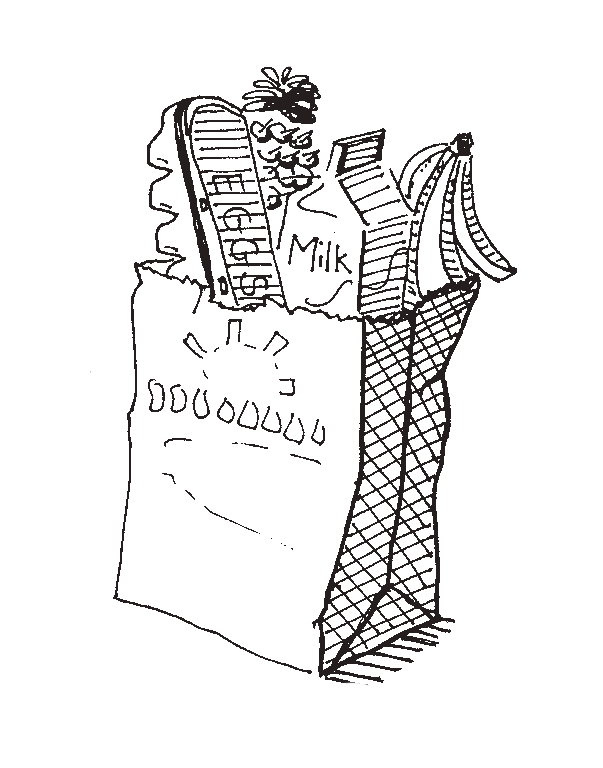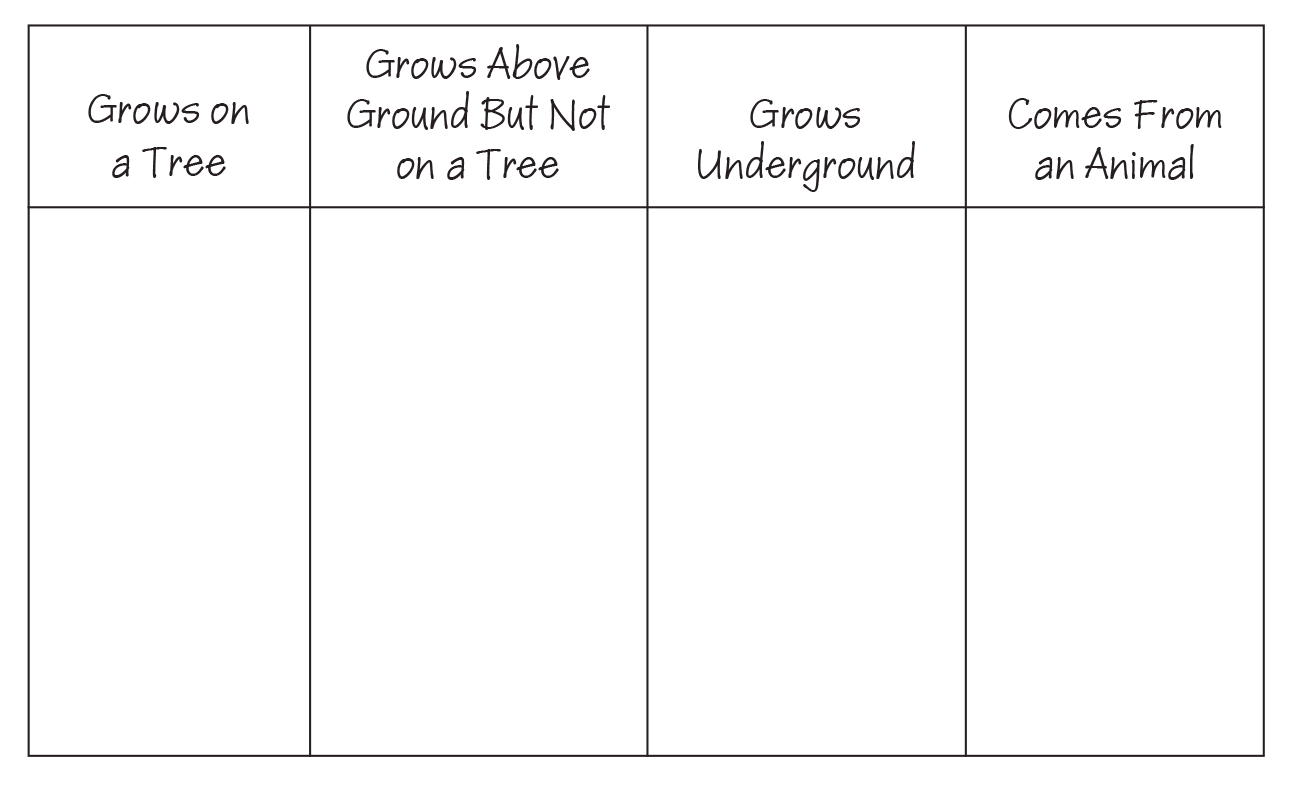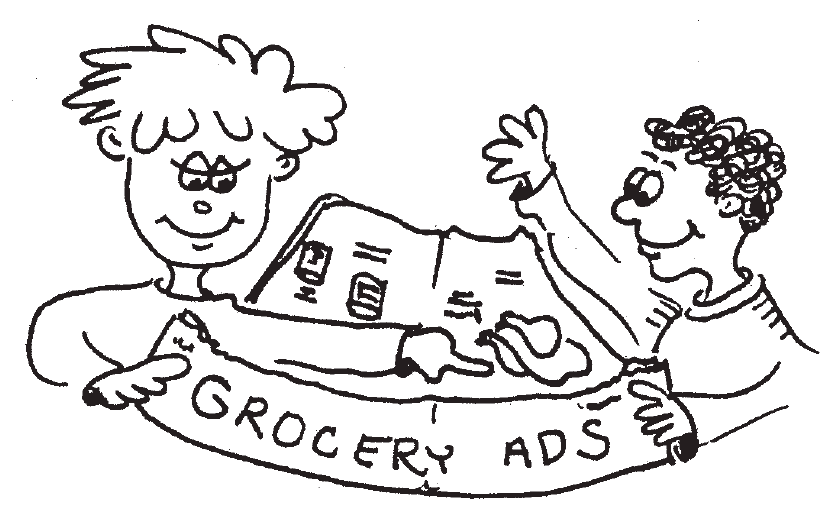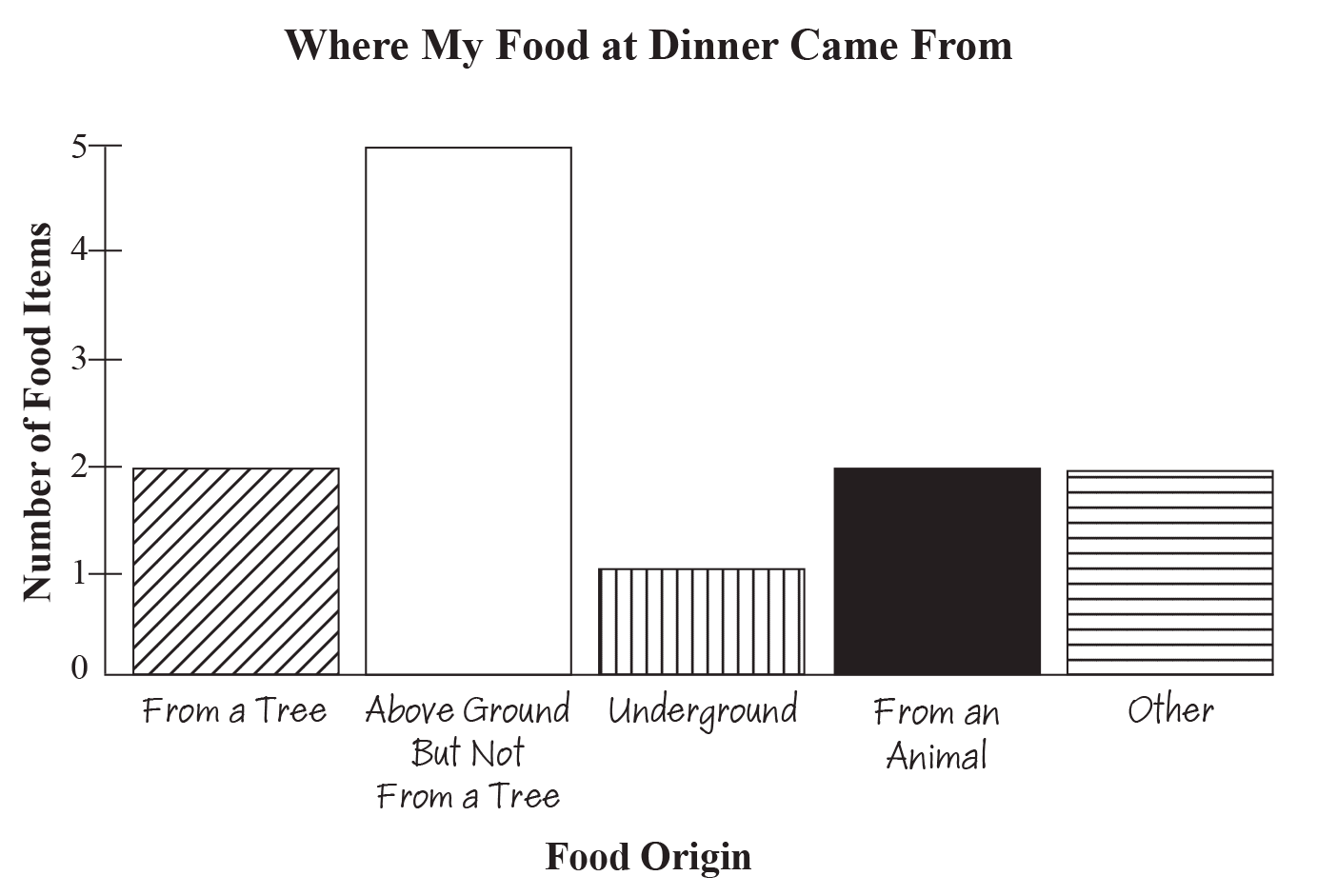Lesson Plan
Edible Numbers
Grade Level
Purpose
Students develop a working vocabulary regarding food, categorize foods by their sources, examine grocery ads, learn about food production, and apply what they learned by analyzing foods they eat at a particular meal. Grades 3-5
Estimated Time
Materials Needed
Activity 1: Food Classification
- Food Pictures, 1 set per group
- Fun Agriculture Facts packets, 1 per group
- Large poster board, butcher paper, or construction paper, 1 per group
- Markers
- Old magazines with pictures of food
- Old seed packages (optional)
- Scissors
- Tape or glue
Activity 2: Scavenger Hunt
- Scavenger Hunt 1 activity sheet, 1 per group
- Grocery ads
- Sample grocery ads (optional)
- Scissors
- Tape
- Paper on which to show mathematics work
- Pencil
Activity 3: Food Nutrition
- I Am What I Eat! activity sheet, 1 per student
- Cherry Breakfast Bar Nutrition Facts
- Meat Franks Nutrition Facts
Vocabulary
fruit: the part of a plant that develops from the flower and contains the seeds of the plant
grain: the edible seed or seed-like fruit of grasses that are cereals (such as wheat, corn, and rice)
meat: the muscle of an animal used as food
recommended daily allowance (RDA): the amount of nutrient (as a vitamin or mineral) that is recommended for daily consumption by the Food and Nutrition Board of the National Academy of Sciences
tuber: a thickened underground portion of a stem or rhizome which bears buds
vegetable: any edible part of a plant that does not contain seeds
Did You Know?
- The American farmer today provides food for about 165 people in the world.1
- Not only do soybeans provide cooking oil, livestock feed, edamame, and soy milk but they also can make 82,368 crayons from 1 acre.2
- The average American consumes consumes 646 pounds of dairy products a year.3
Background Agricultural Connections
Since all students eat food and wear clothing, one natural connection between education and the real world is agriculture. Advances in agricultural technology are continually making headlines and are an excellent way for educators to connect current trends and innovations to the lives of every student. Give the questions below some thought. These questions are commonly asked by children when shopping in a grocery store with an adult.
- How much does it cost?
- Where does steak come from?
- Why are there scales in the produce section of the grocery store?
- Is this healthy?
- Is it on sale?
- How much change will I get in return?
- How did this food get to the grocery store?
- Who grew this food?
Grocery shopping provides many opportunities for children to gain knowledge about mathematics, nutrition, and agriculture. Edible Numbers provides teachers with lessons that relate experiences in the grocery store to classroom mathematics and nutrition education. For this lesson, student experience shopping in a grocery store would be required for helping them gain an understanding for categorizing foods, identifying where certain foods come from, and analyzing food nutrition.
 Food origins, nutrition, and grade-level appropriate mathematics (addition, subtraction, multiplication, division, graphing, problem solving, and statistics) are taught in this lesson. The interdisciplinary approach in Edible Numbers makes it suitable for self-contained classrooms, core, and home school settings. Grocery advertisement scavenger hunts are the highlight of this unit. Use them as they are written, or incorporate single lessons from the unit into an already established curriculum.
Food origins, nutrition, and grade-level appropriate mathematics (addition, subtraction, multiplication, division, graphing, problem solving, and statistics) are taught in this lesson. The interdisciplinary approach in Edible Numbers makes it suitable for self-contained classrooms, core, and home school settings. Grocery advertisement scavenger hunts are the highlight of this unit. Use them as they are written, or incorporate single lessons from the unit into an already established curriculum.
Food can be classified in a variety of ways. For example, meat is the flesh of an animal used as food. A vegetable is a plant or plant part, such as leaves from kale or a stem from asparagus, that we eat. Some vegetables, such as potatoes, are classified as tubers. A tuber is a thickened underground portion of a stem that bears buds. Fruits are the sweet and fleshy product of a tree or plant containing seeds, such as strawberries or oranges.
In this activity, students classify foods according to their origins. There is no set way of classifying food in this manner; however, the following four groupings may be used—food that grows on a tree, food that grows above ground but not on a tree, food that grows underground, and food that comes from an animal. Feel free to have the students form different classification headings. The idea is to practice sorting and to establish a common vocabulary for use in the upcoming scavenger hunt lesson. Examples of food from the various categories are described below:
 Nutrition fact labels provide information that can be useful when determining the nutritional value of a product. They contain the recommended daily allowance, known as the RDA which is the estimated amount of calories per day, determined by the Food and Nutrition Board of the National Research Council and the National Academy of Sciences, necessary for good health. The ingredients are listed in order of quantity. For example, the main ingredient in a cherry breakfast bar is wheat flour, which is produced by a grain that is a cultivated cereal crop used as food. The second ingredient is sugar, and the third ingredient is cherries. If this were a food your students were to record on a chart, they would check three or more boxes—Grows Above Ground But Not On a Tree for the wheat, Grows Underground for the sugar, Grows on a Tree for the cherries, etc.
Nutrition fact labels provide information that can be useful when determining the nutritional value of a product. They contain the recommended daily allowance, known as the RDA which is the estimated amount of calories per day, determined by the Food and Nutrition Board of the National Research Council and the National Academy of Sciences, necessary for good health. The ingredients are listed in order of quantity. For example, the main ingredient in a cherry breakfast bar is wheat flour, which is produced by a grain that is a cultivated cereal crop used as food. The second ingredient is sugar, and the third ingredient is cherries. If this were a food your students were to record on a chart, they would check three or more boxes—Grows Above Ground But Not On a Tree for the wheat, Grows Underground for the sugar, Grows on a Tree for the cherries, etc.
Students will examine one specific meal and classify it into the categories they used in the introductory activity. If you feel an evening meal is not appropriate for your students to examine, have them analyze their breakfast or lunch meal. The idea is to have students take a closer look at what they are eating so they understand where their food comes from and identify a farmer's role in producing food. At the same time, the students will be asked to think of how they could have altered their meal to make it more nutritious.
Engage
- As a class, brainstorm different ways food is grown. Some examples include: grows on a tree, grows above ground but not on a tree, grows underground, grows on a plant, comes from a vine, or comes from an animal.
- As a class, determine the four groups the students will use to categorize the food they eat and write them on the board as category headings. Four possible categories are shown in the chart below.
- Record at least five responses from the students in each category.
- While recording their answers, remind the students that farmers are responsible for growing and raising the foods listed in the chart.
- Keep the chart visible throughout the lesson as a reference.

Explore and Explain
Preparation:
- For student groups of three or four, make copies of the Food Pictures.
- Collect magazines, seed packages, catalogs, and grocery advertisements that students can cut up and use for their posters.
- Create Fun Agriculture Facts packets for each group. You may duplicate pages and/or use other information you find about agriculture. The information can be placed in manila envelopes and used again for different purposes.
Activity 1: Food Classification
- Organize students into groups of three or four.
- Distribute the Food Pictures. Have the students sort the pictures into the four class-determined groups. Discuss the results.
- For each group, distribute the Fun Agriculture Facts packets, magazines and pictures of food, markers, poster paper, scissors, glue sticks, and a piece of chart or butcher paper.
- Have the students divide their poster paper into four sections, and label each section with one of the categories, similar to those used in the Interest Approach — Engagement section.
- In each quadrant, have the students paste at least four pictures that fit the heading. They must label each picture clearly with the name of the food item. Foods that fit in more than one category may not be used.
- Using the Fun Agriculture Facts packets, have the student groups find at least eight interesting facts about the pictures they put on their posters. These facts should be written on a piece of paper and will be used as part of a guessing game during their poster presentation. Challenge the students to record at least one food fact that relates its origin to growing on the farm. An example might be, "There are 200 varieties of this fruit and it can be grown in a farmer's orchard." (plums) In order to use this clue, the students would have plums on their poster.

- Have the students present their posters to the class. As part of the presentation, have a group member read their facts, one at a time, allowing time for classmates to guess which food item they are referring to.
- Direct a class discussion to clarify and correct student work.
- Discuss key vocabulary terms that were new to the students.
Variations
- Instead of group posters, each group can research one category. Combine the efforts of each group to create a class poster.
- Instead of making posters, have each group use a large paper to design a floor game based on food origins.
Activity 2: Scavenger Hunt
- Gather at least 40 grocery ads for students to use. Many grocery stores and newspaper manufacturers will save ads for use in the classroom. As an alternative, photocopy the Sample Grocery Ads included in the lesson, and make them available to students.
 Review mathematics vocabulary with your students. The terms they should understand include sum, difference, total price, product, place value in decimals, etc. Students will search through grocery advertisements to find a part of an advertisement that satisfies a particular problem on the scavenger hunt.
Review mathematics vocabulary with your students. The terms they should understand include sum, difference, total price, product, place value in decimals, etc. Students will search through grocery advertisements to find a part of an advertisement that satisfies a particular problem on the scavenger hunt.- Organize students into pairs. Provide each group with grocery ads, a Scavenger Hunt activity sheet, scissors, and tape.
- Have each team look through the grocery ads and find an ad that satisfies each one of the questions on the Scavenger Hunt activity sheet. Have the students cut out the ads (picture and price) and tape it (top part only) on top of the clue they think it satisfies.
- Have each member of the team show, on his/her own paper, the mathematics required to prove the ads they chose satisfy the clues. Emphasize that neatness and organization is required, so their work can easily be followed.
- Discuss that many of the problems require a sequence of calculations.
- Note: The teacher should circulate among the groups as students work on the activity and discuss the mathematics necessary to substantiate the ad being chosen for the clue. Group papers (one Scavenger Hunt activity sheet with ads taped to it and individual papers) should be collected and graded for mathematical content.
 Variations:
Variations:
- Complete the activity as a class.
- Have one team correct another team's work.
- Use parent volunteers or "big buddies" to assist with reading clues or finding ads.
Activity 3: Food Nutrition
- In preparation, review the I Am What I Eat! activity sheet. If it will meet your needs, make one copy for each student. Otherwise, create an activity sheet that will be more suitable for your students.
- Project copies of the Cherry Breakfast Bar Nutrition Facts and Meat Franks Nutrition Facts on a large screen. Take advantage of the opportunity to talk with students about nutrition as you examine the food label examples.
- Ask the students to think to themselves about what they ate for breakfast. On a sheet of paper, have them draw a picture of where they think their food came from. For example, if they drank orange juice, they would draw an orange tree. Allow five minutes for quick sketches.
 Display the Cherry Bar Nutrition Label. Have students discuss what they see, where the ingredients for this breakfast bar came from, and how the ingredients were grown.
Display the Cherry Bar Nutrition Label. Have students discuss what they see, where the ingredients for this breakfast bar came from, and how the ingredients were grown.- Distribute the I Am What I Eat! activity sheet or the activity sheet you created. Ask the students what boxes they would check if they actually ate a cherry breakfast bar. This will lead into a discussion about where food comes from. If appropriate, examine and discuss the amount of fiber, fat, calcium, and protein found in this product.
- Explain to the students that they will be collecting data on the food they eat for a particular meal. They will need to keep careful track of the foods they eat and drink. As they consume them, they are to write them down on the chart and then check the appropriate boxes. One food item may require several checks. For more clarification, complete the I Am What I Eat! activity sheet with a meal that you ate prior to class and display as a reference for the students.
- Have students make a bar graph of their individual data. The graph should contain the categories across the bottom on the horizontal axis (x-axis) and the quantity (number of entries in a particular food category) of food eaten on the vertical axis (y-axis).

- Have a class discussion on their findings. Sample discussion topics may include:
- In which category does the majority of food you ate belong?
- In which category does the majority of fruits belong?
- In which category does your favorite food belong?
- In which category does a farmer produce the food?
- In a well-written paragraph, have students write what they learned about where their food comes from. They should check their work for completeness in paragraph development, i.e. include a topic sentence, details to support thoughts, and a concluding sentence. They should also check for proper punctuation, spelling, and capitalization.
- Students can read aloud their paragraphs for more understanding and discussion.
Variations
- Have students collect data for an entire day (24 hours) rather than for just one meal.
- Make a bar graph to show the results.
- Have students write a report that includes a cover page, data, bar graph(s), and a conclusion.
- Have students compile data and generate graphs using a computer.
Elaborate
-
Play the My American Farm interactive game Grocery Grab.
-
Have the students look through magazines or cookbooks to find a recipe or meal that includes food from each of the four categories. Make a class recipe booklet.
-
Bring in various foods for the students to see, touch, smell, and taste. Use this opportunity to introduce the students to foods they may have never seen or eaten.
-
Have the students compare the bar graphs from Activity 3 within their group and discuss or write reasons for the differences.
-
Have the students write stories or poems about growing food.
-
Have the students write thank you notes to local farmers for growing their favorite foods.
-
Arrange for a farmer to visit your classroom to speak about his/her occupation.
-
Visit a farmer's market and observe the variety of fresh food.
Evaluate
At the conclusion of this activity, review and summarize the following key concepts:
- Farmers grow and raise plants and animals that we eat.
- Agriculture is important to everyone.
- Packaged foods purchased in grocery stores contain nutrition fact labels to help us make good dietary decisions about the foods we eat.
- Without farmers growing the food that we eat and producing the fiber used to make the clothes we wear, these important items would not be easily available.
Sources
- http://www.agfoundation.org/resources/food-and-farm-facts-2017
- http://www.wisoybean.org/news/soybean_facts.php
- https://www.ers.usda.gov/data-products/dairy-data/
Acknowledgements
The development of this lesson was funded by the California Beef Council and the California Foundation for Agriculture in the Classroom. To meet the needs of California educators and students, Edible Numbers was revised to support the curriculum Content Standards for California Public Schools and updated to include current statistics. Funding from the California Farm Bureau Federation and private donations made this revision possible.
Illustrators: Jack Armstrong, Joanne Borovoy, Karen Holtman, Pat Houk, and Ann Rogers
Layout and Design: Nina Danner
Recommended Companion Resources
Author
Organization
| We welcome your feedback! If you have a question about this lesson or would like to report a broken link, please send us an email. If you have used this lesson and are willing to share your experience, we will provide you with a coupon code for 10% off your next purchase at AgClassroomStore. |